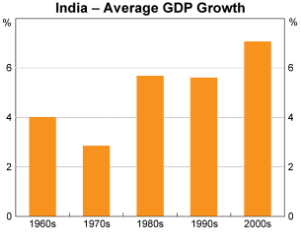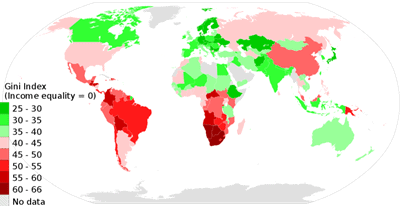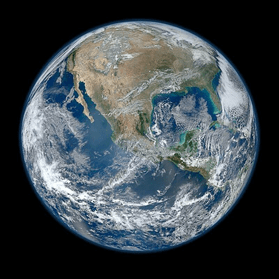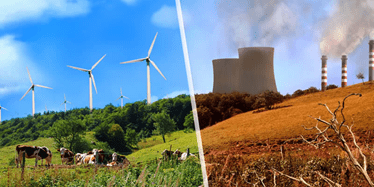- Different people can have different developmental goals
- What may be development for one may not be development for the other person. It may even be destructive for the other.
 Economic Development of India
Economic Development of India
- Development is the sum total of income plus quality of life. Besides seeking more income one way or another, people also seek things like equal treatment, freedom, security, respect for others.
- Different people have different goals in their life. What may be development for one may not be developed for another. This can be understood by the following:
Example: To get more electricity, an industrialist may want more dams. But this may submerge the land and disrupt the lives of people who are displaced, such as tribes. - One common thing among all people is the desire for more income. With this income, they buy goods and services for their daily needs. Quality of life depends on non-material things also.
Example: A job may give you less pay but may offer regular employment that enhances your sense of security.
- Ideas of development differ at an individual and national level.
Example: A landless rural labourer may desire more days of work and better wages at the individual level, but at the national level, he may want a good education and health facilities in the local area.
- The average income can be calculated by dividing national income by the population. It is also called per capita income.
 Gini coefficient of India and other countries according to the world bank (2014), Higher Gini Index means more income inequality
Gini coefficient of India and other countries according to the world bank (2014), Higher Gini Index means more income inequality
- The standard of living of people in a country depends on their per capita income. Countries with higher per capita income are more developed than others with less per capita income.
- Education and health also play an important role in the country’s development.
To know about other criteria we should be familiar with some terms:
(a) Infant Mortality Rate (IMF): It indicates the number of children who die before the age of one year, as a proportion of 1000 live children born in that particular year.
(b) Literacy Rate: It measures the proportion of the literate population in the 7 and above age group.
(c) Net Attendance Ratio: It is the total number of children of age group 6-10 attending school as a percentage of a total number of children in the same age group. - The human development index is the quality of life index prepared by UNDP.
It has mainly three indicators:
(a) Life Expectancy at Birth: It denotes the average expected length of life of a person at the time of birth.
(b) Gross Enrollment Ratio: It shows the enrollment ratio in primary schools, secondary schools and in higher education.
(c) Per Capita Income: It is calculated in dollars for all countries so that it can be compared.
Adding all the three indicators and dividing by 3, gives the human development index:
LE = Life expectancy
GER = Gross enrollment ratio - Human Development Report published by UNDP is useful for comparison between different countries regarding the educational level of their people, their health status and real per capita income.
- When we think of a nation or a region, besides average income, public facilities are equally significant attributes.
- Public Facilities: These are the services provided by the government to its citizens. Some of the important public facilities include infrastructure, sanitation, public transport, health care, water, etc.
- Public facilities are those which are provided by the government to satisfy the collective needs of the people.
Example: Schools, hospitals, community halls etc. It is the best and the cheapest way to provide these goods and services collectively.
Sustainable development is a process that fulfils the needs of the present generation, without causing any harm to the ability of the future generations to meet their own needs. Achieving Sustainability will enable the earth to continue supporting human life
Achieving Sustainability will enable the earth to continue supporting human life
- It requires the preservation of stock of resources including exhaustible natural resources and environmental resources.
- Recent studies show that groundwater in India is exhausted because of overuse. 1/3rd of the country is overusing its groundwater reserves.
- Another area is the exhaustion of natural resources. The resources of crude oil would last only for 43 years.
Q.1: What is the main criterion used by the World Bank in classifying different countries?
Ans: The World Bank uses average income or per capita income as a criterion for classifying different countries.
Q.2: What do final goods and services mean? (2014)
Ans: The various production activities in the primary, secondary and tertiary sector produce large number of goods and services for consumption and investment are final goods and services.
Q.3: “What may be development for one may not be development for the other.” Explain with a suitable example. (Board Question)
Ans: Different persons have different notions of development because life situations of persons are different. For example, Construction of dams leads to generation of hydroelectricity, thus development. However many people have to be displaced from their villages, hence it may not be development for them.Q 1. Why do we use averages? Are there any limitations to their use? Illustrate with your own example related to development.
We use averages for comparisons across different classes.
Limitations of Using Averages: Averages calculate only the mean availability but they hide the disparities in the process. This is the main limitation of using averages.
Let us consider two countries A and B, each having 4 citizens.
Education Level of Citizens
From the above example, we observe that in-country B all citizens have the graduate level of education. There are fewer disparities in this country whereas, in country A, half the citizens are illiterate or of primary education level whereas the other half are doctorates or postgraduates. Therefore, even though the average education level of both A and B is graduate level, yet there are great disparities between them.
Q 2. List a few examples of environmental degradation that you may have observed around you.
Due to advancements in information technology and communication, the whole world has become one. Further, free movement of investment over the greater part of the world has made national economies less and less national. They have become interlinked, interdependent national economies.
Example: Environmental degradation due to the overuse or misuse of the resources such as freshwater will have a direct impact on the whole world. Evidence suggests that water hunger would be one of the worst problems in near future. Similarly, overuse of mineral wealth.
Example: Petrol in one part of the world, has a deep impact on the other parts of the world also.
Generation of domestic, urban, and industrial pollution is taking place today beyond the earth’s capacity to absorb. Hence, we can say that environmental degradation is not just a national issue.
Environmental Degradation
Q 3. Differentiate between renewable and non-renewable energy resources. Find out the present resources of energy in India.
- Renewable energy resources are the resources that are replenished by nature. They could not exhaust because they would continue year after year.
Example: Groundwater, solar energy, wind energy, etc.
- While non-renewable energy resources get exhausted after years of use. These resources cannot be replenished. Crude oil and coal are examples of non-renewable energy resources.
Present resources of energy in India: crude oil, coal, thermal power plants are present resources of energy in India that would run out of stock in 43 years. We have to find out alternative energy resources which do not cause any damage to the environment.
Q 4. (a) What does Human Development Index (HDI) indicate?
(b) By whom HDI is prepared?
(a) Human Development Index (HDI): It makes a rating of all countries on a scale of 0 to 1. 0 indicates the lowest human development and 1 indicates the highest human development.
Two important points about HDI are:
(i) It measures relative and not the absolute level of human development.
(ii) The main emphasis of HDI is on goals, i.e. longevity, knowledge, and standard of living (expressed in real per capita income).
(b) United Nations Development Programme (UNDP) has been preparing the HDI since 1990.
Q 5. “Money cannot buy all the goods and services that one needs to live well.” Explain.
- It is true that money cannot buy all the goods and services that one needs in life. A person earning a good income would still need the support of the government for the basic needs of education and health.
- Money cannot buy respect, peace of mind, equality and freedom, and all other ideals of life cherished by all in society. Money cannot ensure a pollution-free and germ-free environment in the world.
Q 6. Mention any three characteristics of Development.
Three characteristics of Development are:
(i) The desire to improve one’s present situation leads to development. The process involves thinking about ways in which we can work towards improving our present condition.
(ii) Development goals for one may be different from the goals of others.
Example: Your sister’s career goals may be different from your career goals.
(iii) Different development goals may become conflicting development goals.
Example: The construction of a dam may be good for the industrialist, however, it may obstruct the development goals of the villagers who were evicted from the area for the construction of the dam.
Q 7. Explain the two basic tools used to compare an underdeveloped country with a developed country?
The two basic tools used to compare an underdeveloped country with a developed country are:
(i) Per Capita Income: Countries with a per capita income of USD 12616 per annum and above in 2012 are called rich countries or developed countries. Countries with a per capita income of USD 1035 or less are called low-income or underdeveloped countries. This tool is used by the World Bank for comparison of countries.
(ii) Human Development Index: According to this tool of measurement, countries are ranked on the basis of their life expectancy, literacy rate, and health status, etc. Countries with high life expectancy, literacy rates are considered as developed, whereas, countries with low expectancy rates are called underdeveloped. This tool is used by the United Nations for comparing an underdeveloped country with a developed one.
Q 8. How does the National Development of a country depend on the availability of public facilities?
- To bring equality in the National economy, public facilities are provided by the government especially for those sections of society who are unable to make use of the facilities provided by the private sector. The Government, at times in collaboration with private firms, provides basic health care, education, etc at subsidized rates or even free of cost.
- The Public Distribution System in India provides food grains and other essential items to the people living below the poverty line. Health care which includes free immunization and hospitalization at a subsidized cost is also provided by the Government for the weaker sections of the society for their development.
Q 9. Why do different individuals have different and at times conflicting goals for development?
Each individual is different with different needs in life. Some development goals important for one person may not be important for the other. There are certain development goals that are common for all such as a good source of income, security of job, freedom, and equality. However, certain goals can be different for people.
Example: (a) Employment opportunities might be an important goal for educated unemployed youth. However, improvement in irrigation facilities might be the development goal of a farmer. At times the different development goals become conflicting goals for all.
(b) Cutting of forests might be important for the timber industry, however, it would displace the tribals of that region whose livelihood might be dependent on that forest.
Q 10. “The Earth has enough for everyone’s needs but not for everyone’s greed.” Explain the need for sustainable development in the context of the above statement.
The statement, “The Earth has enough for everyone’s needs but not for everyone’s greed,” means that we are overusing the natural resources of the Earth in the name of Development. Sustainable development is when development takes place without degrading the environment. Under sustainable development, the needs of the present generation are not compromised. However, at the same time, the natural resources are also conserved for the future generation.Q 1. Why do we use averages? Are there any limitations to their use? Illustrate with your own example related to development.
We use averages for comparisons across different classes.
Limitations of Using Averages: Averages calculate only the mean availability but they hide the disparities in the process. This is the main limitation of using averages.
Let us consider two countries A and B, each having 4 citizens.
Education Level of Citizens
From the above example, we observe that in-country B all citizens have the graduate level of education. There are fewer disparities in this country whereas, in country A, half the citizens are illiterate or of primary education level whereas the other half are doctorates or postgraduates. Therefore, even though the average education level of both A and B is graduate level, yet there are great disparities between them.
Q 2. List a few examples of environmental degradation that you may have observed around you.
Due to advancements in information technology and communication, the whole world has become one. Further, free movement of investment over the greater part of the world has made national economies less and less national. They have become interlinked, interdependent national economies.
Example: Environmental degradation due to the overuse or misuse of the resources such as freshwater will have a direct impact on the whole world. Evidence suggests that water hunger would be one of the worst problems in near future. Similarly, overuse of mineral wealth.
Example: Petrol in one part of the world, has a deep impact on the other parts of the world also.
Generation of domestic, urban, and industrial pollution is taking place today beyond the earth’s capacity to absorb. Hence, we can say that environmental degradation is not just a national issue.
Environmental Degradation
Q 3. Differentiate between renewable and non-renewable energy resources. Find out the present resources of energy in India.
- Renewable energy resources are the resources that are replenished by nature. They could not exhaust because they would continue year after year.
Example: Groundwater, solar energy, wind energy, etc.
- While non-renewable energy resources get exhausted after years of use. These resources cannot be replenished. Crude oil and coal are examples of non-renewable energy resources.
Present resources of energy in India: crude oil, coal, thermal power plants are present resources of energy in India that would run out of stock in 43 years. We have to find out alternative energy resources which do not cause any damage to the environment.
Q 4. (a) What does Human Development Index (HDI) indicate?
(b) By whom HDI is prepared?(a) Human Development Index (HDI): It makes a rating of all countries on a scale of 0 to 1. 0 indicates the lowest human development and 1 indicates the highest human development.
Two important points about HDI are:
(i) It measures relative and not the absolute level of human development.
(ii) The main emphasis of HDI is on goals, i.e. longevity, knowledge, and standard of living (expressed in real per capita income).
(b) United Nations Development Programme (UNDP) has been preparing the HDI since 1990.
Q 5. “Money cannot buy all the goods and services that one needs to live well.” Explain.
- It is true that money cannot buy all the goods and services that one needs in life. A person earning a good income would still need the support of the government for the basic needs of education and health.
- Money cannot buy respect, peace of mind, equality and freedom, and all other ideals of life cherished by all in society. Money cannot ensure a pollution-free and germ-free environment in the world.
Q 6. Mention any three characteristics of Development.
Three characteristics of Development are:
(i) The desire to improve one’s present situation leads to development. The process involves thinking about ways in which we can work towards improving our present condition.
(ii) Development goals for one may be different from the goals of others.
Example: Your sister’s career goals may be different from your career goals.
(iii) Different development goals may become conflicting development goals.
Example: The construction of a dam may be good for the industrialist, however, it may obstruct the development goals of the villagers who were evicted from the area for the construction of the dam.
Q 7. Explain the two basic tools used to compare an underdeveloped country with a developed country?
The two basic tools used to compare an underdeveloped country with a developed country are:
(i) Per Capita Income: Countries with a per capita income of USD 12616 per annum and above in 2012 are called rich countries or developed countries. Countries with a per capita income of USD 1035 or less are called low-income or underdeveloped countries. This tool is used by the World Bank for comparison of countries.
(ii) Human Development Index: According to this tool of measurement, countries are ranked on the basis of their life expectancy, literacy rate, and health status, etc. Countries with high life expectancy, literacy rates are considered as developed, whereas, countries with low expectancy rates are called underdeveloped. This tool is used by the United Nations for comparing an underdeveloped country with a developed one.
Q 8. How does the National Development of a country depend on the availability of public facilities?
- To bring equality in the National economy, public facilities are provided by the government especially for those sections of society who are unable to make use of the facilities provided by the private sector. The Government, at times in collaboration with private firms, provides basic health care, education, etc at subsidized rates or even free of cost.
- The Public Distribution System in India provides food grains and other essential items to the people living below the poverty line. Health care which includes free immunization and hospitalization at a subsidized cost is also provided by the Government for the weaker sections of the society for their development.
Q 9. Why do different individuals have different and at times conflicting goals for development?
Each individual is different with different needs in life. Some development goals important for one person may not be important for the other. There are certain development goals that are common for all such as a good source of income, security of job, freedom, and equality. However, certain goals can be different for people.
Example: (a) Employment opportunities might be an important goal for educated unemployed youth. However, improvement in irrigation facilities might be the development goal of a farmer. At times the different development goals become conflicting goals for all.
(b) Cutting of forests might be important for the timber industry, however, it would displace the tribals of that region whose livelihood might be dependent on that forest.
Q 10. “The Earth has enough for everyone’s needs but not for everyone’s greed.” Explain the need for sustainable development in the context of the above statement.
The statement, “The Earth has enough for everyone’s needs but not for everyone’s greed,” means that we are overusing the natural resources of the Earth in the name of Development. Sustainable development is when development takes place without degrading the environment. Under sustainable development, the needs of the present generation are not compromised. However, at the same time, the natural resources are also conserved for the future generation.What Development Promises– Different People, Different Goals
Brief :
Development has many aspects. People have different perspectives on development and there are ways by which we can arrive at common indicators for development.
Different persons have different notions of development. They seek different things. They seek things that are most important for them.
Different People Have Different Goals
What may be development for one may not be development for the other.
Example: Landless labourer require better wages and work, Adivasi from Narmada Valley need rehabilitation.
Sometimes conflicting aims are there as well.
For example, dams, are a reason for the displacement of some but provide electricity for the industrialists.
Income and Other Goals
One common thing about the developmental goals of different persons is more income or a regular and steady source of income.
Besides seeking more income, one or the other, people also seek equal treatment.
Freedom, security & respect of others.
They never like discrimination.
The developmental goals are not only about better income but also about other important things in life such as equal treatment, freedom, security and respect for others.
National Development
Different persons have different notions about national development goals such as industrial development or agricultural progress or computer literacy.






No comments:
Post a Comment